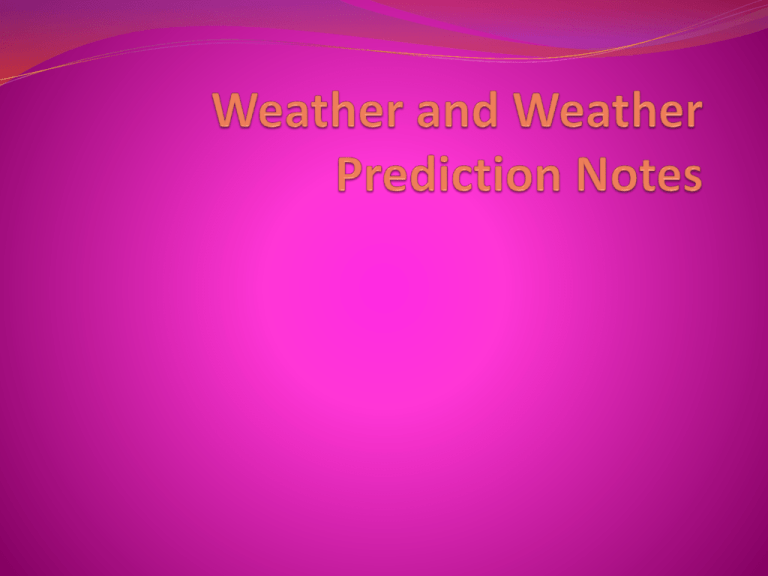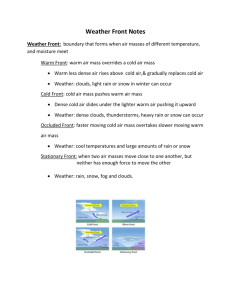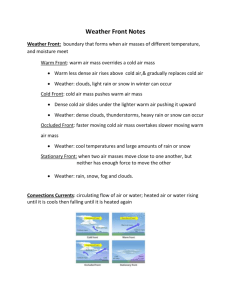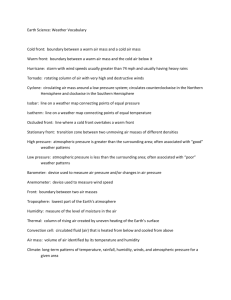Weather Prediction PPT
advertisement

Weather Weather atmosphere ___________= the condition of the _____________at a particular _______and _______ time place Forecast prediction Weather ___________= a _____________of future ___________weather conditions over the next 3 to 5 _________days Weather Station Model Diagram outline of station model: (pg. 105) Temp _____ Pressure __________ Weather _____________. Cond Dew Point __________ Precip amt ____________ Surface station model Surface observation data station model: EX. -located on map where _________was located data Cloud Cover Cloud cover = shade in circle EX. Wind Direction Wind direction _________direction = ______in ___________wind is line coming _________ FROM EX. Wind speed Wind speed = Ex. Pressure- measured in __________(mbar) millibars 9 greater # is _________than 500, put a ____in front and a decimal ___________one place from the right Ex. 802….980.2 10 less # is ________than 500, put a _____in and a decimal one place right from the _________ Ex. 347…..1034.7 EXAMPLES Temperature ________________= measure of how _______or hot _________something is cold Dew temperature _______Point = the _____________air must cool saturated ________to be completely____________ Saturated: reached moisture compacity Examples Turn to page 105 Your turn Fronts edge air boundary Fronts = leading _______of an ______mass/_________ Warm Front Warm = _______air replacing __________air warm cooler snow/rain -weather = (indicated________________) cirrus thin feathery, found at a. ________clouds –_______, ________altitudes high stratus layers b. _________-clouds that form in __________ -nimbostratus precipitation c. steady _____________________ increased d. _____________temp Cold Front replacing ________= cool air ____________warmer air Cold weather = cumulous puffy ____________clouds___________white clouds, tend flat to have _________bottoms -cumulonimbus brief ________showers decreased ___________temp Occluded Front Occluded __________= (type of cold front) cold front ____________up with warm front catching cuts off ground -“_________” warm air mass from ___________ severe -_________weather a. high wind b. hail c. lightening d. tornado e. heavy rain Stationary front Stationary two ___________= _______air masses can not _______other ______of way push out steady -weather = _________rain until moves out Frontal Weather Air mass = a large amount of air that takes on the temperature and humidity of the area it forms over Continental tropical (cT) = warm, dry — . Mexico, SW US . Continental polar (cP) = cold, dry -- Canada Frontal Weather Maritime tropical (mT) = warm, moist – S. Pacific, S. Atlantic . Maritime polar (mP) = cold, moist – N. Pacific, N. Atlantic Frontal Weather Cyclone = low pressure area containing rising warm air -winds . rotate counter clockwise in Northern Hemisphere - tornados, hurricanes Anticyclones = high pressure area -cool, dry air rotates clockwise in N. hemisphere . Isobar Iso= same Isobar = lines that connect points of equal air pressure - closer the line, the stronger the wind Isobars closer together = higher winds Isobar Map Isotherm Isotherm = lines that connect points of equal temperature - use color for each decade of #’s - reds are warm / blues are cooler Isotherm Map Predicting Weather Generally -US weather moves from W to E because US is in the “westerlies” global wind pattern - Low pressure spins counter clockwise - High pressure spins clockwise Predicting Weather - -High pressure = clear weather - Low pressure = cloudy/stormy weather Significant temp change (decrease) and - significant pressure change down = may cause severe weather Weather Instruments - Thermometer – air temp -Anemometer – wind speed - Barometer – air pressure - Psychrometer – - Rain gauge humidity – rain fall amount - Wind sock/vane – wind direction








